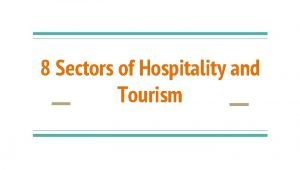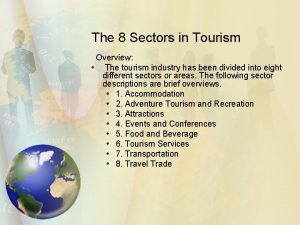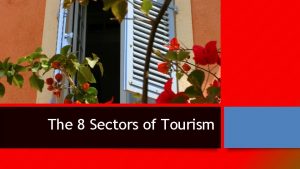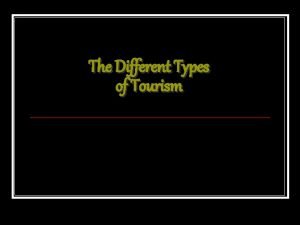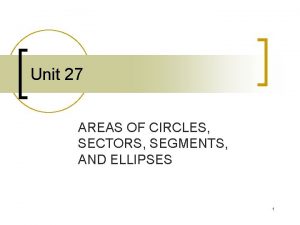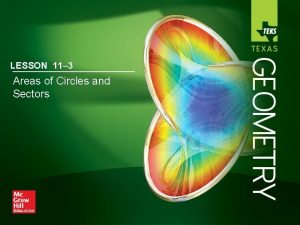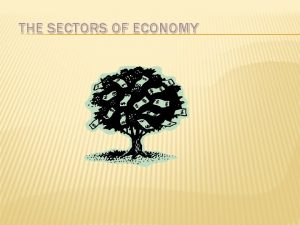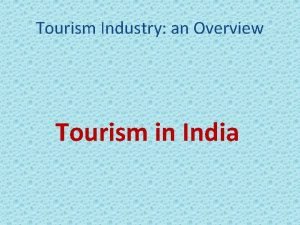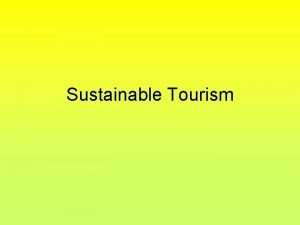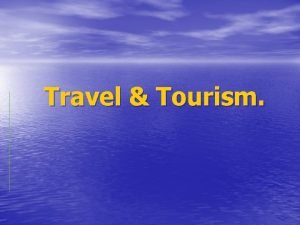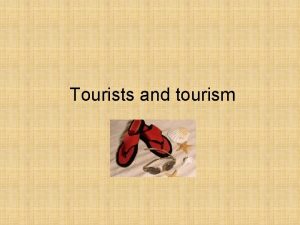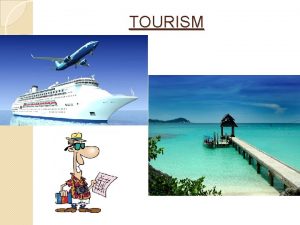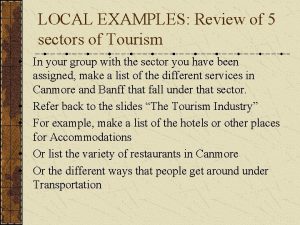The 8 Sectors in Tourism Overview The tourism


































- Slides: 34

The 8 Sectors in Tourism Overview: • The tourism industry has been divided into eight different sectors or areas. The following sector descriptions are brief overviews. • 1. Accommodation • 2. Adventure Tourism and Recreation • 3. Attractions • 4. Events and Conferences • 5. Food and Beverage • 6. Tourism Services • 7. Transportation • 8. Travel Trade

1. ACCOMMODATION • Accommodation is one of the largest and fastest growing sectors in the tourism industry. In 1997, approximately 173, 000 people were employed in hotels and other lodging operations in Canada. Between 1986 and 1996, accommodation services experienced growth of 39%. Reasons for this are: • • demand is extending beyond traditional seasons, e. g. conferences during the summer at ski resorts • • growth of large chains and increased interest in vacation or time-share concepts • • increased interest in Canada as a destination. • The benefits of growth are reaped by those looking for careers in this sector. New jobs are being created, movement along one's career path is accelerated, opportunities for positions and careers in different regions and types of establishments are increasing.

Hotels: • Hotel properties usually cater to both business and pleasure travellers and offer a wide range of accommodation types. • Deluxe, airport and convention hotels are generally located in urban centres or near airports. They are often large (over 150 rooms) and have a wide range of facilities and services (e. g. convention rooms, restaurants, shops, fitness centres). Many are members of a chain, meaning that the property is part of a larger company and has sister properties in other areas. The benefit of working at a chain to an individual employee might be the ability to transfer to other properties in the chain. • All-suite hotels are increasingly popular. Each unit contains the same facilities as an apartment, meaning the traveller has a private place for meetings (i. e. the dining room table) and a kitchen for cooking meals.

• Smaller, privately owned hotels offer lodging and many also contain a café or restaurant, and a beverage room. • Resort hotels and lodges are usually located in or near recreational sites. Many offer guests a wide range of activities, such as golf, skiing, tennis, riding or water sports. They may also offer entertainment (e. g. nightclubs, shops, piano bars, casinos, dinner theatre) and have convention facilities. • Motels, motor hotels and inns are often much smaller (less than 150 rooms), less expensive facilities that appeal to overnight or short-stay travellers. Some motels are franchise or chain operations, others are independently owned and operated. Motels are often found in smaller communities, the suburbs of cities and along major highways.

• • Bed and Breakfasts and Farm/Ranch Vacation Sites Cabins, Cottages and Houseboats Campgrounds Hostels

TYPES OF POSITIONS IN THE ACCOMMODATION SECTOR • Front Office and Guest Services This is usually the most visible department of a property, and is often where a guest has initial personal contact. Individuals employed in reservations, guest services and front desk reception are all part of this department.

• Administration Administrative staff plan and co-ordinate all operations. Administration includes the areas of management, human resources, finances, purchasing, and sales and marketing. • Food and Beverage Food and beverage outlets can range from restaurants and bars to nightclubs and posh • dining rooms. Kitchen staff, room service staff, food and beverage servers and bartenders are just some of the positions that are available in this area.

• Housekeeping, Maintenance and Fitness: • Housekeeping and maintenance are essential departments in any property. Those working in these departments often have little direct contact with guests, however their services add significantly to guest satisfaction. Fitness is a newer area of the accommodation sector, and positions are available for those who have expertise in the monitoring of equipment or products and their use, and in setting programs for those wishing to work out.

2. ADVENTURE TOURISM AND RECREATION • Adventure tourism and recreation, like the accommodation sector, is growing fast. Changing trends in travel and tourism, where clients request active, recreational experiences or travel adventures where they can learn about nature and/or culture, are driving the growth. This sector includes everything from bird watching to salmon fishing, horseback riding to white water rafting, golf to wilderness trekking. Adventure tourism and recreation draws those who want to experience Canada as a place that is natural and unspoiled, and those who want active, unusual vacations.

There are over eighty different occupations in the adventure tourism and recreation sector. The opportunities for small business owner/operators are limited only by the creativity of the operators. Total Canadian employment in this sector in 1997 was 71, 100 and this is expected to grow to 90, 000 by 2005. The major areas of this sector are:

A. Outdoor Adventure and Ecotourism • Many travellers seek adventure, challenge and excitement in an outdoor setting. Canada is blessed with a wide diversity of relatively unspoiled wilderness areas that support these types of activities. Hiking, cycling, mountaineering, canoeing, kayaking, sailing, horseback riding, river rafting, scuba diving, sky diving, snowmobiling, and nature/ wildlife viewing are just some of the activities included in this portion of the sector. In addition, there are many Canadian businesses dedicated to fishing our lakes and oceans, and hunting or photographing wild animals.

B. Ski Resorts • Over two million Canadians regularly ski or snowboard. There are nearly 300 alpine ski areas in Canada and hundreds of ski clubs to serve them. Canada's top five resorts enjoy steady growth. These resorts attract skiers and boarders from across the country, and large numbers of foreign travellers from around the world, especially from Japan, Britain and Germany.

C. Golf and Tennis Facilities • Almost five million Canadians golf. Annual industry revenue is almost $1 billion. There are 1800 golf courses in Canada and golf holidays are becoming increasingly important to the economy. • Another popular summer sport is tennis. Many clubs and resorts offer tennis courts, tennis lessons and tennis gear. This is also an important part of the industry, with revenue earned through the sale of clothing and gear, the rental of courts, the training of players and the maintenance of equipment.

D. Parks • There are 38 national parks and 792 national historical sites in Canada. In addition, all provinces and territories have regional parks, and most urban and rural municipalities have parks and habitat protection areas. Many people are involved in planning, maintaining, promoting, patrolling and interpreting these areas. Positions are as varied as the sector.

E. Marine Facilities • • Across Canada, water and water-based activities are popular with Canadians and visitors alike. Activities include fishing, swimming, sailing, windsurfing, waterskiing, canoeing, and sea-dooing. Related businesses include marinas, tour boat excursions, sport fishing lodges, fly-in fishing camps and boat rental operations. On both the east and west coasts, there are thriving marine businesses ranging from whale-watching tours to deep-sea fishing adventures. As in all portions of this sector, instructors are an important part of the industry. Those who have mastered an activity to a point where they can teach others to do it can market these abilities to employers in this sector.

3. ATTRACTIONS • Every province and territory in Canada has major and minor attractions that attract visitors and generate tourism revenue. Attractions include historic sites, heritage homes, museums, halls of fame, art galleries, botanical gardens, aquariums, zoos, water parks, amusement parks, casinos and cultural attractions. Many attractions are educational in nature, others are solely for entertainment.

4. EVENTS AND CONFERENCES • A. Special Events : There a growing number of special events that encourage travellers to go to areas to which they may not otherwise go. Many of these events are so successful that they have become national or international attractions.

B. Conferences, Meetings, Trade Shows and Conventions • Business people frequently meet to share ideas, research and information, to solve problems or to develop new strategies or products, and/or to be trained. Organizations send their staff to sales meetings, professional development conferences and networking conventions. Companies exhibit their wares at specialized exhibitions and trade shows. • Club or association members, specialists in various fields, and special interest groups also gather at conventions. They travel across the country or across the globe.

5. FOOD AND BEVERAGE • The food and beverage industry is a $32 billion a year industry. Over 700, 000 people in Canada are employed in this sector. Another 213, 000 positions are expected by 2005. The food and beverage sector is also a major youth employer and a major training ground for many employees who are beginning their working careers.

6. TOURISM SERVICES • The tourism services sector is made up of the organizations, associations, government agencies and companies that specialize in serving the needs of the tourism industry as a whole rather than the needs of travellers specifically. • There are several areas that make up this sector.

A. Government : • Government organizations encourage business by providing money, information and services. For example, governments collect valuable market research and market or promote destinations. Government policies also affect tourism indirectly. Building a new airport, expanding a park system, improving a highway, levying a hotel tax: these actions impact one or all of the tourism sectors.

• The federal government focuses on promoting Canada as a tourist destination to international markets. • Each province and territory has its own ministry, department or agency of tourism that recognizes the value of tourism and supports its growth. This office often works with municipalities, tourism associations or chambers of commerce to achieve regional goals, strengthening and diversifying the tourism products and services available, and fostering marketing, research and promotional activities.

B. Industry Associations: • Industry associations have been established to serve either the entire industry or specific sectors. Some industry associations focus on marketing, e. g. Prince Edward Island Convention Bureau and the Canada West Ski Marketing Council. Other associations (such as the tourism education councils found in every Canadian province and territory) focus on education, training and professional development of those working in the tourism industry.

C. Marketing Services: • Marketing is the promotion by an organization of the various services it has available for the purpose of attracting customers. Due to the amount of competition, consumers have a large variety of products and services from which to choose. Marketing is of primary importance to tourism, and many organizations have specialized marketing staff and services.

D. Research: • Researchers and analysts can be found in many government tourism departments, and at market research firms. Market research is essential in order to make informed plans and decisions. Information collected may be about an organization's own market and/or about competitors' markets. The reports that are generated from this research are useful in planning and decision-making. They measure the impact of tourism on the economy and find out what tourism consumers need and expect.

E. Retail: • Retail businesses that benefit from tourism revenue are also part of the tourism services sector. Travellers who shop for the socks they forgot at home, or who get a hair cut while travelling, contribute dollars to the local economy.

7. TRANSPORTATION • Tourism was earlier defined as an industry that provides for the movement, comfort and enjoyment of people. The 'movement' in this definition is addressed by the transportation sector. • The sector is divided into four categories: Air, Rail, Ground and Water. The following text offers an overview of each area.

A. Air Transport: • • Air remains the primary mode of domestic travel, after private vehicles. The 'Open Skies Agreement' reached in February 1995 allows airlines (instead of governments) to decide which transborder routes they want to fly. Since then, transborder traffic has increased by 31%. With increased traffic comes the benefit of more jobs in the industry. As passenger traffic continues to increase, airports are undergoing major renovations, and are expanding retail operations and marketing efforts. This also means new positions are created.

B. Rail Transport: • Via Rail, Canada's only national passenger rail service carries approximately 3. 8 million passengers annually. There also smaller regional railways that employ staff for positions from selling tickets to operating the train. Rail travel is a relaxed, scenic way to travel, and is becoming increasingly popular as a vacation, rather than only as a way to get to a vacation spot.

C. Ground Transport: • The majority of Canadian travellers use private vehicles to travel within the country. There is a whole support industry for people and their cars. There also other types of ground transportation businesses, including motor coach travel, taxicab operations and vehicle rental companies. Again, there are many positions in each of these types of companies.

D. Water Transport: • • • Marine-based businesses include ferry companies, marinas, cruise lines, water taxis and other forms of water transportation. Large numbers of Canadians take water cruises each year, many of them cruising up or down the coast of BC. There also ferries that link highways across the country. Ferry travel can be on a vessel that holds one or two cars and travels for four or five minutes each way, or can be a huge super ferry that transport millions of people each year on journeys that take from half an hour to all-day treks. All of these different methods of travel have associated job opportunities. The variety of positions in this sector is large, and many jobs allow employees to travel and explore Canada and the world.

8. TRAVEL TRADE • The travel trade sector supports the bookings and sales in the other sectors. The people that work in the travel trade make reservations for accommodations, tours, transportation, food and beverage and/or for attractions. These bookings can be in the form of an all-encompassing tour package or a single booking for a single traveller. • There are two subcategories in the travel trade sector.

A. Retail Travel Agencies: • Travel agencies sell travel packages as well as individual travel components, such as airline tickets, car rentals and hotel reservations. They sell directly to the public, to both business and pleasure travellers.

B. Wholesale Tour Operators: • Tour operators and wholesalers develop and package tours to sell to the retail trade, i. e. travel agencies. Often these tours are allinclusive (that is, they include all travel, accommodation, meals, and entertainment) and are marketed to encourage specific markets to buy, e. g. employee incentive travel; convention-related or special interest travel, such as theatre, sports or bird watching tours. • Some tour operators specialize in tours to international destinations; others focus on groups coming into Canada.
 8 sectors of tourism industry
8 sectors of tourism industry 8 sectors of hospitality and tourism
8 sectors of hospitality and tourism Different sectors of tourism industry
Different sectors of tourism industry Mass tourism vs alternative tourism
Mass tourism vs alternative tourism 11-3 areas of circles and sectors answer key
11-3 areas of circles and sectors answer key The scope of fma 1967 covers in the following sectors
The scope of fma 1967 covers in the following sectors Area of an arc
Area of an arc Areas of circles and sectors practice
Areas of circles and sectors practice Volume maze answer key
Volume maze answer key A type of graph that shows a circle divided into sections
A type of graph that shows a circle divided into sections Quaternary economic activity
Quaternary economic activity Sectors and segments
Sectors and segments Lesson 10-7 areas of circles and sectors
Lesson 10-7 areas of circles and sectors Cadca 7 strategies
Cadca 7 strategies Copenhagen school five sectors of security
Copenhagen school five sectors of security Bond sectors
Bond sectors Klint walker
Klint walker 11-3 areas of circles and sectors answer key
11-3 areas of circles and sectors answer key Arc lengths and areas of sectors
Arc lengths and areas of sectors Tertiary in business
Tertiary in business Tỉ lệ cơ thể trẻ em
Tỉ lệ cơ thể trẻ em Lời thề hippocrates
Lời thề hippocrates đại từ thay thế
đại từ thay thế Vẽ hình chiếu đứng bằng cạnh của vật thể
Vẽ hình chiếu đứng bằng cạnh của vật thể Quá trình desamine hóa có thể tạo ra
Quá trình desamine hóa có thể tạo ra Môn thể thao bắt đầu bằng chữ đua
Môn thể thao bắt đầu bằng chữ đua Công của trọng lực
Công của trọng lực Thế nào là mạng điện lắp đặt kiểu nổi
Thế nào là mạng điện lắp đặt kiểu nổi Hát kết hợp bộ gõ cơ thể
Hát kết hợp bộ gõ cơ thể Sự nuôi và dạy con của hươu
Sự nuôi và dạy con của hươu Dot
Dot Nguyên nhân của sự mỏi cơ sinh 8
Nguyên nhân của sự mỏi cơ sinh 8 Phản ứng thế ankan
Phản ứng thế ankan Chó sói
Chó sói Thiếu nhi thế giới liên hoan
Thiếu nhi thế giới liên hoan
